Where Do Copperheads Nest?
The copperhead snake is one that you very well might have seen before if you live in the East or Southeast parts of the United States. These slithering creatures are more common than you’d think, and if you live in an area near them, it’s probably in your best interest to learn how to avoid them. Generally speaking, these snakes don’t seek out confrontation. In fact, their expert camouflaging helps them secure their desire to slip by unnoticed and unbothered. However, there are a few places where they’re more likely to be found. In this article, we’ll highlight the most common places where copperheads nest, as well as what makes those areas so appealing to these snakes. We’ll also learn a thing or two about avoiding these nests once you identify them, to make sure that we can continue to peacefully coexist with these interesting creatures.
Identifying A Copperhead Snake
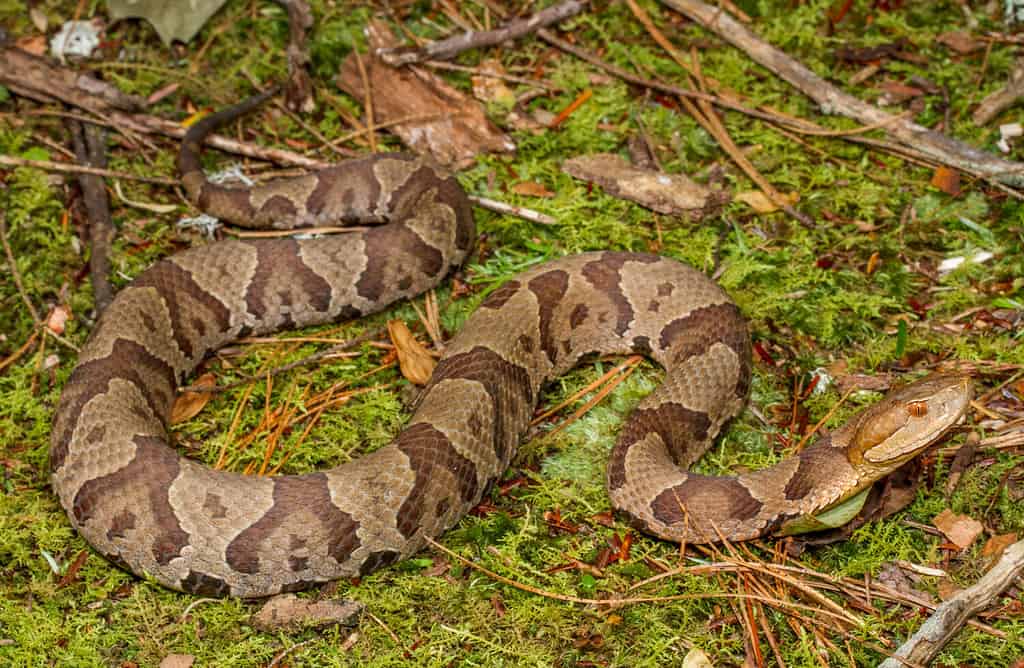
©JacobLoyacano/Shutterstock.com
Before you can actually discern where copperheads nest, it would certainly help to understand what they look like! Copperhead snakes are very common, and have a basic red-brown and beige color combination on their skin. Male copperheads are typically larger than females, but they all grow roughly between 25 and 40 inches in length. They have dark brown bands throughout their bodies, which is a key identifier for the species. Something that these snakes are excellent at is camouflaging, as their color scheme and patterns allow them to blend in seamlessly with their natural environment.
Places Copperheads Are Most Frequently Found
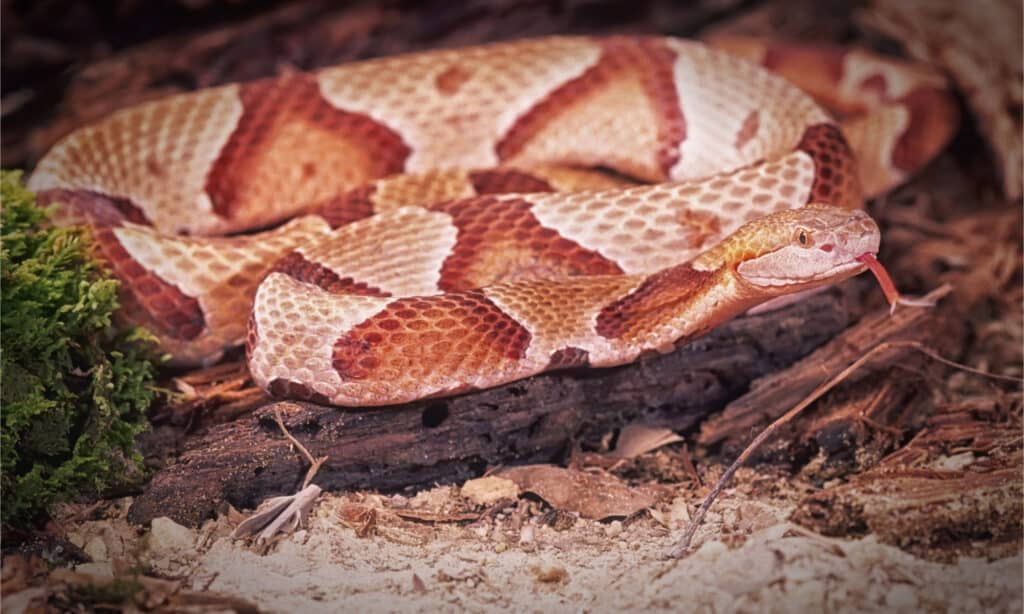
©outdoorsman/Shutterstock.com
Copperheads are native to the eastern, southeastern, and central parts of the United States. If nothing else, these snakes are certainly adaptable. They are known to occupy habitats of many types, from wetlands to riverbeds, but there are a few specific spots that they’re more well-known for. Copperheads have a natural inclination toward forested areas, so this is certainly their most popular choice of habitat. In particular, they enjoy deciduous forests. This is because their coloration (as we had mentioned earlier) helps them to blend right into their environment.
Aside from forests, rocky terrains on the outskirts of these forested spots are also common for copperheads to be found in. That’s because of the small cracks and crevices that are usually found between rock piles. Copperheads enjoy using these spots for a few reasons, but primarily because the vantage point it gives them is excellent for locating and stalking their prey.
How Copperheads Choose Their Nesting Sites
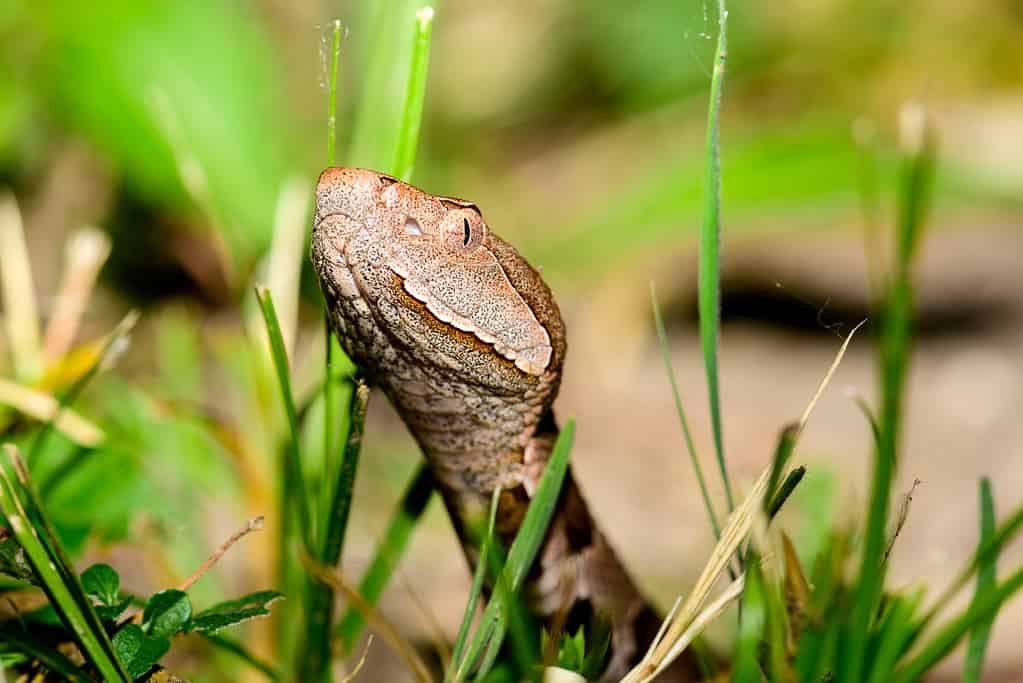
©iStock.com/JWJarrett
There are specific criteria in mind when selecting the spots that copperheads nest in. Some of these are more blatantly obvious, but others are interesting and species-specific. Here are some of the most heavily considered things for copperheads when choosing their nesting sites:
- Safety: Obviously, safety is their top priority. Their site must provide shelter from predators, which include raccoons and other kinds of snakes. So, they are likely to choose somewhere that’s secluded and well-hidden.
- Versatile Temperatures: Something interesting about copperheads is that they are ectothermic. This means that their internal temperature is determined by whatever is happening externally. They need to find nesting sites that allow them to stay balanced. This means access to sunlight for warmth, but shade for when things get too heated.
- Food Sources: A snake’s got to eat! Copperheads nest in areas with access to food, which to them are typically birds, small mammals, or large insects.
Snake Nesting Sites Versus Denning Sites
You might often hear the terms “snake nest” and “snake den” used interchangeably. In reality, though, these two things are quite different. Each of these locations serves a specific purpose for the snakes and their behaviors. A nesting site, the subject of this article, is specifically chosen by females to give birth and provide care for their young. Most of the time, these areas are only temporary.
Denning sites, on the other hand, are where snakes hide away during the winter to brumate, which is essentially a form of hibernation. As opposed to being singular, the snakes den away in large groups. Funnily enough, there have even been instances of the phenomenon referred to as “communal denning,” wherein various snake species (including copperheads) occupy the same den during the winter season. Some examples of the other kinds of snakes that copperheads have been known to communally den with are timber rattlers and black rat snakes.
Tips For Identifying (And Avoiding) Copperhead Nests
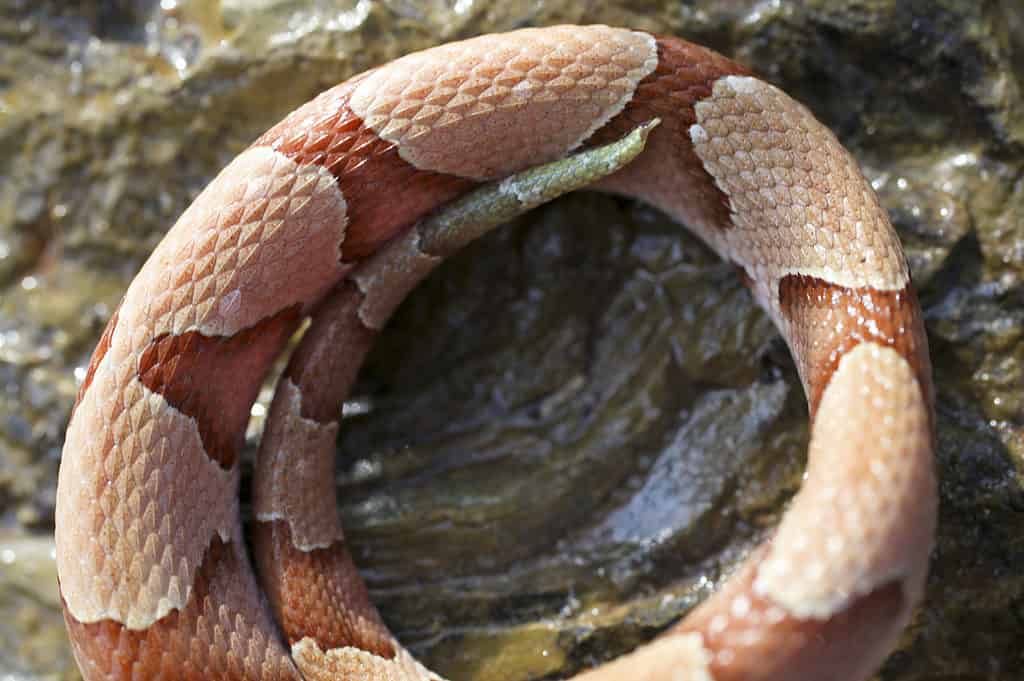
©iStock.com/Vektive
So, let’s say that you live in a part of the US that has a hefty copperhead population. Chances are you don’t want to have a bad encounter with these snakes. The best bet of avoiding such an encounter is understanding their behavior and recognizing them before they get a chance to become startled by you. Luckily, there are some tips and tricks that can help you identify and avoid the nest of a copperhead without any unwanted incidents.
First off, always take caution when you’re going into one of their preferred habitats. This means keeping a cool head in dense forests and rocky outlying areas. If you notice a strong presence of prey, like mice or birds, always keep in mind that there could be just as many predators.
When you’re moving along your path, try not to disturb any debris that you run into if it isn’t necessary. This could be pretty much anything, from logs to rocks to piles of leaves. Don’t just reach down and move these things, try to use something extended to brush them out of your way when needed. Especially exercise caution during the night time, as this is when copperheads are most notoriously active!
On your own property, don’t keep that guard down. If you have a barn or other backyard structure that you haven’t investigated in a while, use caution when looking through it. The same goes for gardening! If you plan on moving things around to plant something new, don’t go in with your hands. Use some kind of rake or hoe to disturb the area first to reveal sneaky snakes that might be hiding!
Getting Rid of Copperheads on Your Property
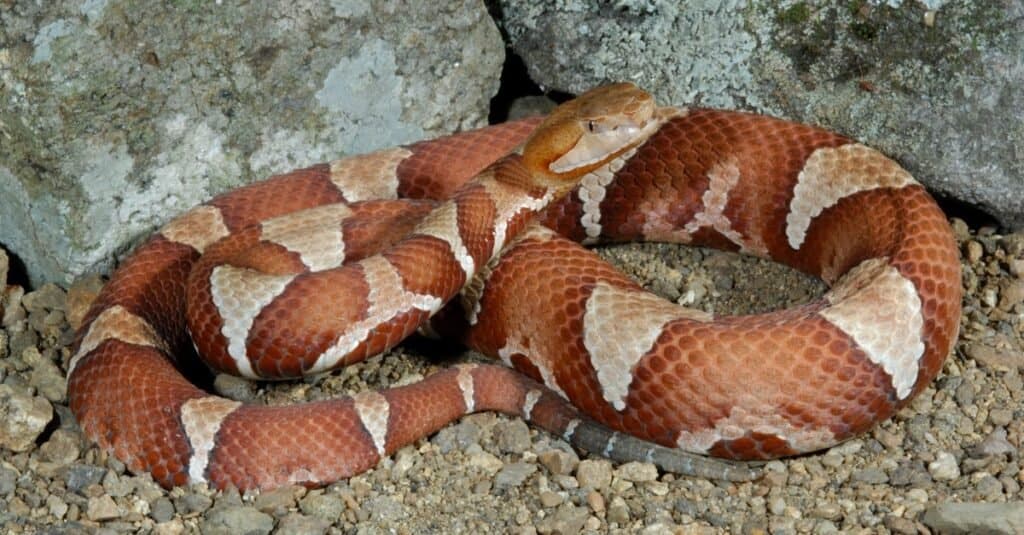
©Breck P. Kent/Shutterstock.com
Seeing a copperhead snake (or especially a copperhead’s nest) on your property is a scary feeling. These venomous snakes aren’t anything to scoff at, despite their low mortality rates. You might be inclined to take matters into your own hands, but it’s heavily advised that you don’t do that. If you have children or pets around, it might still be a good idea to get rid of these snakes, though. Instead of going toe-to-toe with these reptiles, contact the proper authorities. Many areas, especially those known to have large copperhead populations, will know how to handle the situation from there.
If you still want some tips on making your yard less hospitable for copperheads in the future, take some of these final words of advice:
- Remove any areas that the snakes could seek refuge in. This could be leaves, rocks, or even large piles of trash.
- Get rid of tall grass and unprotected vegetation that could provide a good hiding spot for the snakes.
- Try to keep your pushes pruned off of the ground when possible.
- If you’re particularly known for attracting snakes, try investing in a snake repellent.
- Always be aware. Use gloves, wear boots, and always stay alert!
Discover the "Monster" Snake 5X Bigger than an Anaconda
Every day A-Z Animals sends out some of the most incredible facts in the world from our free newsletter. Want to discover the 10 most beautiful snakes in the world, a "snake island" where you're never more than 3 feet from danger, or a "monster" snake 5X larger than an anaconda? Then sign up right now and you'll start receiving our daily newsletter absolutely free.









